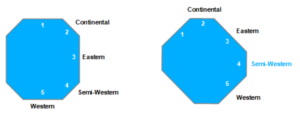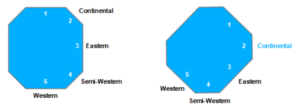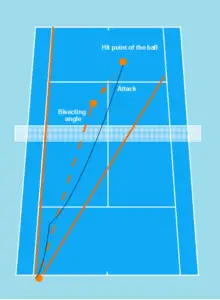Learn attack shot
The perfect tennis attack shot
The perfect tennis attack shot
When do I advance to the net after a good shot and try to put the opponent under even more pressure and possibly finish with a the volley to win the point? Many tennis beginners ask themselves this question again and again and often miss the right time to move forward because they act a little hesitantly. This does not have to be the case.
A well played attacking shot allows you to shorten the rallies and save energy. At the same time, your game becomes much more variable, because you are not only acting from the baseline, but also dictating the game and being active.
In the following we will explain to tennis beginners how to play the perfect tennis attacking ball: from the grip, the backswing, the movement and the outswing to attacking shot tips.
1. Griffhaltung
The attack shot is usually always played with topspin. In rare cases, the slice attack ball is also played, but we will focus on the topspin attack ball below.
a) Forehand topspin
The forehand topspin is played rather aggressively in tennis not only from the baseline, but of course also on the attack ball. The ball is characterized by forward spin and a faster bounce.
For playing the forehand topspin we recommend the so-called Semi-Western grip. This is used by the majority of all tennis players. Here, the racket is slightly bent forward in the lateral position at the top.

b) Backhand topspin
The backhand topspin attack shot is usually played aggressively in tennis to put one’s own stamp on the rally. The backhand topspin attack ball is also characterized by forward spin and a faster bounce.
To play the backhand topspin – one-handed or two-handed – we recommend the so-called Continental grip. Here, the club is slightly bent forward in the lateral position at the top.
As with the forehand, your strong hand again grips the grip as far down as possible. For the two-handed backhand, you also use your weaker hand – the left hand if you are right-handed. Both hands are close together and touch to give the backhand even more stability.

2. Tennis backswing
You are in the center of the court and wait for your opponent to hit you. As always, you hold the tennis racket centrally in front of you in the starting position and have an open foot position in order to be able to react quickly.
As soon as your opponent hits the tennis ball, you do a split step – a two-legged jump on your toes – to be able to pull away in one direction as quickly as possible. Recognizing that the ball is coming shorter than normal, you move forward and turn your body to the forehand or backhand side.
a) Forehand side
You turn your body to the forehand side and at the same time bring the tennis racket out in a circular motion to the top back.
Your upper body is facing the net with your left shoulder as a right-handed player while your racket is extended with your arm in the opposite direction of the net. Your knees are slightly bent and your weight is stable on your back foot.
b) Backhand side
You turn your body to the backhand side and at the same time take out the tennis racket with both hands in a circular motion to the top of the backhand side.
Your upper body is facing the net with your right shoulder as a right-handed player, while your tennis racket is extended with both hands in the opposite direction of the net. Your knees are slightly bent and your weight is stable on your back foot.
3. Tennis movement
A clean movement sequence is crucial. On the attack shot, you hit the tennis ball as it rises, so as soon as the tennis ball bounces in front of you, drop the racket down.
Then you shift your weight from the back foot to the front foot and at the same time turn your upper body back towards the net. At the same time, accelerate the tennis racket with a loose wrist and hit the tennis ball with a “cover” – to create the topspin – in front of your body.
4. Tennis outswing
a) Forehand attack ball
The forehand topspin is finished with the outswing after hitting the tennis ball. You swing the tennis racket out over your left shoulder as a right-handed player, bending your arm as you do so. If you are left-handed, you swing it over your right shoulder.
b) Backhand attack ball
The backhand topspin is finished with the outswing after hitting the tennis ball. You swing the tennis racket over your right shoulder as a right-handed player, bending both arms. If you are left-handed, you swing it over your left shoulder.
Then, depending on where you place the attacking ball, you advance to the net on the bisector of the angle and, as always, do a short split step at the opponent’s point of impact.

Notice that both the backswing, movement sequence and outswing is a fluid movement.
5. Typical attack shot mistakes and tips
Finally, three typical mistakes and tips to improve your attack ball:
a) Do not overpower the attacking ball
If the opponent plays a short ball, you don’t have to try to hit the ball into the opponent’s court full speed – even if the chance is tempting. Most of the time it is enough to place the ball with an aggressive topspin in a deliberate way, not with too much speed. Your opponent, even if the ball can still be played, will feel so pressured that quite often an error will be placed and you will win the point. Therefore, remember that you do not have to make a direct winning shot.
b) Observe your opponent’s path of play
Many tennis beginners always look only at the tennis ball and don’t see their opponent moving to one corner or another. Especially when the opponent’s ball is too short, the opponent often has to choose a corner in order to have a realistic chance of winning a point. Therefore, also observe the running path of your opponent and aim accordingly into the free corner. This usually leads to a safe point win.
c) Drive the opponent out of the court
Most tennis beginners play the attacking ball longline, but often the attacking ball cross is the better option, because it chases the opponent far out on the court. With good angles, the opponent has to take many steps to still get to the ball and then often plays an all-or-nothing shot, which usually doesn’t work. Therefore, use the whole width of the court and play the attacking ball cross rather than longline.

